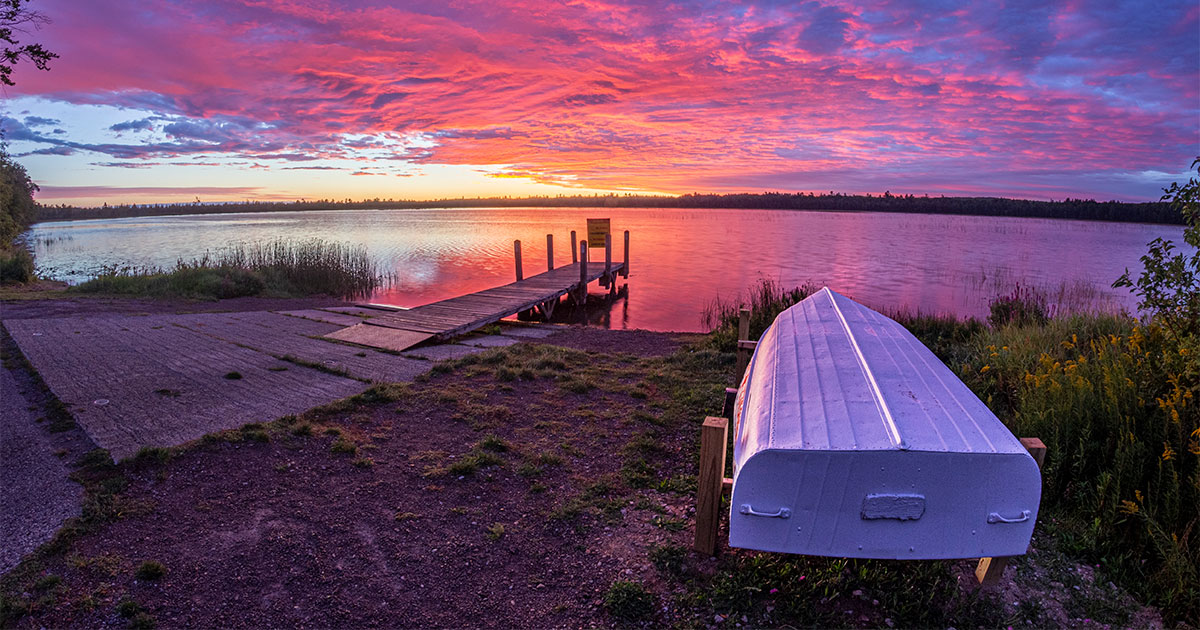
The opinions in this article reflect the views of the author, not the author’s employer or the State Bar of Wisconsin Environmental Law Section.
Wisconsin’s Public Trust Doctrine provides that the navigable waters of the state and the carrying places between them are “common highways and forever free” for the use and enjoyment of all citizens.1
State law has long required and protected the public’s right to get to the water, but many people are unaware that public road ends and platted lots or access strips touching water are theirs to use.
At the same time, neighbors of undeveloped public accesses sometimes spread their lawns, walks, gardens, and structures into those spaces in a manner that discourages public use, and these encroachments present issues for them when they seek to sell their land.
Prior to a sale, the owner of such property may reach out to their local government and ask to buy the public space. They can present their request as a win/win, arguing that the town will get to tax a larger lot, and they will get clean title for their sale. They may also say that the public wasn’t using the access anyway, or that the access attracts teen drinkers or people who leave trash.
But an abandonment request must satisfy Wisconsin’s public access abandonment law, and state standards require notice and an opportunity for a hearing, then a formal decision – and all these things take time.
This article provides a basic understanding of the basis for Wisconsin’s public access law, and discusses the standards that the Wisconsin Department of Natural Resources (DNR) employs in order to approve a town or county action to discontinue a highway, street, alley or right of way that provides public access to a navigable lake or stream in accordance with Wis. Stat. section 66.1006 and Wis. Admin. Code § NR 1.92.
This basic framework may inform those who counsel the neighbors, users, and governments controlling these accesses so that all can understand what is required if a public access is to be legally abandoned. It may help attorneys whose clients seek to protect, preserve, and enjoy these public spaces, because public accesses are becoming increasingly more difficult to replace.
The Public Trust and Public Access
Wisconsin has a lengthy and well-developed legal framework establishing the public’s right to recreate, fish, and hunt on Wisconsin’s navigable waters, as well as to enjoy their natural scenic beauty.2
 Diane Milligan, U.W. 2001, is deputy counsel with the State of Wisconsin Department of Natural Resources in Madison, where she advises staff in the real estate and property planning programs.
Diane Milligan, U.W. 2001, is deputy counsel with the State of Wisconsin Department of Natural Resources in Madison, where she advises staff in the real estate and property planning programs.
Accordingly, public access sites are used by Wisconsinites who want to swim, fish, canoe, kayak, snowmobile, ski, or drive onto ice, sit or drive by to look at the water, as well as to carry in or launch boats (where facilities exist). They are also used by local governments for emergency response, to obtain water for firefighting, and to accommodate drainage.
An access site does not need to provide for all of these uses. Instead, a steep wooded, undeveloped lot or road end, and a scenic drive running along the shore still provide the opportunity to enjoy scenic beauty, and therefore serves the public interest. A public access must be seen in terms of potential public uses over time, instead of just its past or current use.
History of Public Access Creation and Protection Laws
Since 1923, subdivision plats abutting lakes have been required to include access to the water at half-mile intervals.3 Since 1955, a town’s certification of a plat has served as an acceptance of the dedications “for streets, alleys, ways, commons or other public uses as designated on said plat” as trustee,4 and since 1957, subdividers have been required to provide 60-foot “public access” to the low water mark of lakes and streams.5
Public access may also be created by common law dedication, prescriptive use, validation, or statutory dedication. Thus, it is important to look at the creation and history of a waterway access to determine whether it is a public access protected by law.
Since 1959, Wisconsin law has required that towns and counties that wish to discontinue a highway, street, alley, or right of way that provides public access to navigable water must obtain approval of such action from the DNR (or its predecessor Wisconsin Conservation Commission) before the action may take effect.6
And since 1998, towns and counties have not been able to discontinue public ways to water by abandoning or declining to maintain them.7 Instead, they must take affirmative action pursuant to statute, and that action requires DNR’s approval. For town highways, the process in Wis. Stat. sections 82.10-12 must be used. To discontinue a road, street, slip, pier, lane, or paved alley, a town may use Wis. Stat. section 66.1003. If the access was created by platting, a town or county may join an application to vacation filed with the circuit court under Wis. Stat. section 236.43.
All three statutory methods require affirmative action by a town or county, and that action requires DNR’s approval in order to be effective.
So, although the impetus for a request to abandon or vacate public access is typically initiated by a neighbor who seeks to own the public space, it is the town or county that must seek DNR approval, and in most cases the town or county must also replace the access it seeks to abandon in order to obtain that approval.
DNR’s Process for Evaluating Access Abandonment Requests
DNR’s public access policy for waterways provides:
It is the goal of the state of Wisconsin to provide, maintain and improve access to the state’s navigable lakes, rivers and streams for the public. Public access facilities shall allow for public rights of navigation, related incidental uses and other uses which are appropriate for the waterway. Waterway uses shall be equally available to all waterway users and include enjoyment of natural scenic beauty and serenity. These public rights and uses may be provided by any combination of publicly and privately owned access facilities which are available to the general public free or for a reasonable fee. The department, alone or in cooperation with local government, shall exercise its management and regulatory responsibilities to achieve this goal and to assure that levels and types of use of navigable waters are consistent with protection of public health, safety and welfare, including protection of natural resources.8
A town or county that proposes to abandon or discontinue a public access to navigable water must provide notice to DNR before it takes action, and it must submit a petition seeking DNR’s approval within 10 days after taking action.
The DNR may only grant a petition to abandon or discontinue a public access that contributes to the quality or quantity of public access to a water body if the access is first replaced.9 Wis. Admin. Code § NR 1.92(4) provides that an access site may also be abandoned if environmental degradation has resulted from existing use if the abandonment will reduce or eliminate the degradation without reducing the public’s interests in access to the water body, but it is unclear whether this section has ever been employed.
In evaluating the public interest, DNR looks at all of the public access opportunities and uses accommodated on a water body. In evaluating replacement access, DNR looks to see if equivalent or superior public access will be provided in close proximity to the access to be abandoned, and it may condition its approval in order to ensure that the replacement access is maintained and the public interest is protected.10
If a municipality wants to increase its chances of obtaining DNR approval, the municipality may want to consider replacing the access to be abandoned with clearly superior nearby public access as part of its resolution or ordinance to abandon or discontinue an existing public access.
DNR’s regional access expert makes a recommendation for approval or rejection of a resolution proposing to abandon access based on the guidelines in Wis. Admin. Code § NR 1.92. DNR then provides public notice and an opportunity for a hearing. If a hearing is requested it is handled by the State Department of Administration’s Division of Hearings and Appeals, which issues a formal decision. The DNR issues a formal decision if there is no hearing.
Either decision is subject to judicial review in accordance with Wis. Stat. sections 227.52-227.53, and of course circuit court decisions may be appealed.11
Conclusion: The Time and Costs Factor
As Wisconsin’s navigable waters become more fully developed, there is increasing pressure to privatize the public lots, lanes, and road rights of way that provide public access to the water. The pressure on local governments is greater when they are unaware that a public access exists, or when they feel they lack resources to police the site for encroachments or nuisance behavior. At the same time, it may be even more expensive for the municipality to replace that access with an equivalent or superior access.
These costs and the time it may take to submit an approvable petition should be taken into account when a municipality is asked to consider abandoning an access that it holds in trust for the public. And an approvable petition in turn allows the State to fulfill its public trust duty to protect the peoples’ right to access Wisconsin’s navigable waters.
The time, expense and uncertainty associated with access abandonment petitions might be avoided if existing public accesses were identified and respectfully used by the public.
This article was originally published on the State Bar of Wisconsin’s
Environmental Law Section Blog. Visit the State Bar
sections or the
Environmental Law Section webpages to learn more about the benefits of section membership.
Endnotes
1 Wis. Const. art. IX, § 1.
2
See, e.g., Diana Shooting Club v. Husting, 156 Wis. 261, 271, 145 N.W. 816 (1914);
State v. Public Service Comm’n, 275 Wis. 112, 118, 81 N.W.2d 71 (1957).
3
See Wis. Stat. chapter 223 (1923)(requiring that subdivision roads in unincorporated areas extend to the low water mark).
4
See Wis. Stat. § 236.29(1).
5
See Wis. Stat. chapter 88 (1957), amending Wis. Stat. § 236.16(3).
6
See Wis. Stat. § 66.1006 (formerly Wis. Stat. § 80.41).
7
See Wis. Stat. § 82.19(2)(c).
8 Wis. Admin. Code § NR 1.90(1).
9 Wis. Admin. Code § NR 1.92(2).
10
See Wis. Admin. Code § NR 1.92(3).
11
See,
e.g.,
Citizens for U, Inc., v. DNR, 323 Wis.2d 767, 780 N.W. 2d 194 (2010).
